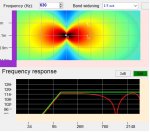I have been asked by a few people if I could put up some details of my dual 10” and horn speaker I mentioned in the DIY Mid Hi thread. I built the original design 18 years ago, it’s now very similar to an active version of JTR’s - 3TX.
So here goes…
It uses the same horn as the DIY double 12” - the RCF HF950, a BMS4594 and the BMS passive crossover. My original boxes used two propriety Australian made 16 ohm Lorantz 10” speakers with an EV HP94 horn.
In 2015 I would suggest something like 18sound’s 10NMB420 or B&C’s 10NDL64, but there are other drivers that would be suitable.
The trick with this design is to cross the two 10” drivers low enough so they act as more or less one source. To do that you need to find a horn the correct size with a low cut off frequency and combine it with a compression driver that is happy to operate that low. This is where the 4594and HF950 are perfect.
I used 650Hz – 24dB LR active crossover plus a few parametric EQs on the HF and LF and some delay to align the drivers at the crossover.
It works perfectly on top of a double 18 sub crossed at about 110Hz. While it has some serious output it’s probably about 10dB less than the DIY double 12 stick horn (D12SH), but is much lighter and easier to build.
Box dimensions
Height – 870 mm
Depth – 375 mm
Width - front - 325mm
Width - back – 200mm
The horn is in a separate enclosure leaving about 40L for the two 10” drivers. If you select a different driver that needs more volume you can include the horn volume i.e. about 60L
Porting – 2 tuned to suit drivers - 65Hz for 18sound and B&C
HF driver – BMS 4594 + crossover
LF drivers - 18sound’s 10NMB420 or B&C’s 10NDL64
If anyone else is interested I will post some more details.
http://www.eighteensound.it/PRODUCTS/Products/CatID/8/ProdID=28#.Vg0NQGkiPaQ
http://www.bcspeakers.com/products/lf-driver/10-0/10ndl64
http://www.bmsspeakers.com/index.php?id=bms_4594nd
http://www.rcf.it/products/precision-transducers/horns/hf950
So here goes…
It uses the same horn as the DIY double 12” - the RCF HF950, a BMS4594 and the BMS passive crossover. My original boxes used two propriety Australian made 16 ohm Lorantz 10” speakers with an EV HP94 horn.
In 2015 I would suggest something like 18sound’s 10NMB420 or B&C’s 10NDL64, but there are other drivers that would be suitable.
The trick with this design is to cross the two 10” drivers low enough so they act as more or less one source. To do that you need to find a horn the correct size with a low cut off frequency and combine it with a compression driver that is happy to operate that low. This is where the 4594and HF950 are perfect.
I used 650Hz – 24dB LR active crossover plus a few parametric EQs on the HF and LF and some delay to align the drivers at the crossover.
It works perfectly on top of a double 18 sub crossed at about 110Hz. While it has some serious output it’s probably about 10dB less than the DIY double 12 stick horn (D12SH), but is much lighter and easier to build.
Box dimensions
Height – 870 mm
Depth – 375 mm
Width - front - 325mm
Width - back – 200mm
The horn is in a separate enclosure leaving about 40L for the two 10” drivers. If you select a different driver that needs more volume you can include the horn volume i.e. about 60L
Porting – 2 tuned to suit drivers - 65Hz for 18sound and B&C
HF driver – BMS 4594 + crossover
LF drivers - 18sound’s 10NMB420 or B&C’s 10NDL64
If anyone else is interested I will post some more details.
http://www.eighteensound.it/PRODUCTS/Products/CatID/8/ProdID=28#.Vg0NQGkiPaQ
http://www.bcspeakers.com/products/lf-driver/10-0/10ndl64
http://www.bmsspeakers.com/index.php?id=bms_4594nd
http://www.rcf.it/products/precision-transducers/horns/hf950
Attachments
Last edited by a moderator:



